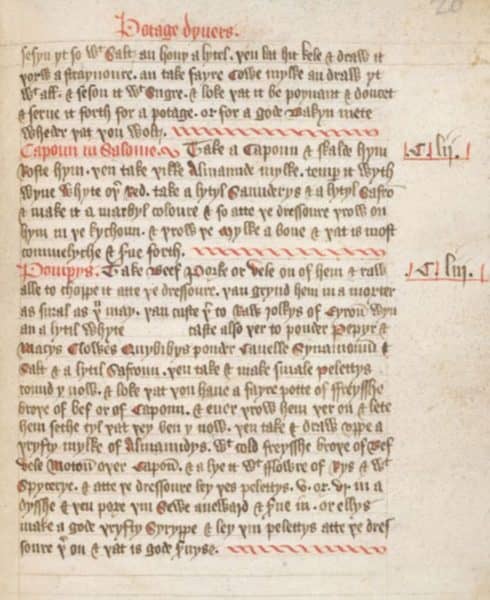Somewhere in the decade around 1430 — with King Henry VI on the English throne — one of the earliest, still extant, cook books was being written called “Potage Dyvers“. It included a list of ingredients (or “bills of fare”) for what, looking at some of them, were likely to be destined to be used exclusively for those planning the most expensive of banquets, available only to the richest in the country. The one I highlight below contains quantities and a range of spices that would have been far beyond the means of us common folk. But ’twas ever thus – these are merely early versions of the modern taste for Beluga caviar or Wagyu beef*.
*[ Yeah, OK, guilty as charged yer honour on those two…]
This graphic shows the page detailing the preparation of “pompys”; to you and me, meatballs

[Interestingly, by now nearly 400 years after the Norman invasion, we’re still using (albeit altered) versions of the original French words e.g. ‘let‘ rather than ‘lait‘ for milk and ‘fryit‘ instead of ‘froid‘ for cold.]
The lack of any precise weights or amounts suggests that it may have been employed as an aide memoire for those household servants responsible for ordering, stocking and managing the huge quantities of exotic ingredients they had to employ. It would also have worked as a guide for the chefs who travelled as part of the extensive supply train that had to accompany their masters as the latter paraded around the country on a seemingly endless circular set of visits to other rich houses. Think of it as the equivalent of the modern day coffee table book of glossy photographs of hugely expensive consumer items; a bragging guide and an attempt at one-upmanship.
Along with clothing materials such as satin, cambric and lawn, using these exotic (and thus obviously expensive ingredients) were also a sine qua non of catering, to ensure that your status as a noble family with access to a huge treasure chest was completely obvious every time your guests sat down to eat at your table. At least by then they’d moved on from the fashion popular with the richest Egyptians whose guests were given a cone of perfumed fat to put on their heads. It slowly melted, allegedly leaving the wearer smelling ‘nice’…
The recipe, such as it is, reads as follows:
MODERN ENGLISH: Take beef, pork or veal – one of them – and raw. Chop it up at the dresser, then grind it in a mortar as small as you can. Then add raw yolks of eggs, wine, and a little white sugar. Also add powdered pepper, mace, cloves, cubeb [a pungent Indonesian spice], canella [an inferior form of cinnamon], cinnamon, and salt, and a little saffron. Then make it into small pellets, round enough. Make sure you have a good pot of fresh broth of beef or capon, and ladle it on and let it boil till they are done enough. Then take good milk of almonds, with cold fresh broth of beef, veal, mutton or capon, and mix it with rice flour and with the spices. And at the dresser, put the pellets in a dish, and then pour on the sauce, and serve. Or else make a good syrup and lay the pellets on top at the dresser, and that is good service.
Take Beef, Porke, or Vele, on of hem, & raw, alle to choppe it atte þe dressoure. þan grynd hem in a morter as smal as þou may. þan caste þer to Raw jolkys of Eyroun wyn an a lytil whyte […] caste also þer to pouder pepyr & Macys Clowes Quybibys pouder Canelle Synamoun & Salt & a lytil Safroun. þen take & make smale Pelettys round ynow. & loke þat þou haue a fayre potte of Freysshe broþe of bef or of Capoun, & euer þrow hem þer-on & lete hem sethe tyl þat þey ben y-now. þen take & draw vppe a þryfty mylke of Almaundys with cold freysshe broþe of Bef, Vele, Moton, oþer Capoun. & a-lye it with floure of Rys & with Spycerye. & atte þe dressoure ley þes pelettys in a dysshe. & þen pore þin sewe aneward, & serue in, or ellys make a gode þryfty Syryppe & ley þin pelettys atte þe dressoure þer on, & þat is gode seruyse.
I’ll be reporting back shortly on how they taste…
[The translation and graphic come courtesy of the British Library. Shelfmark: Harley MS 279]